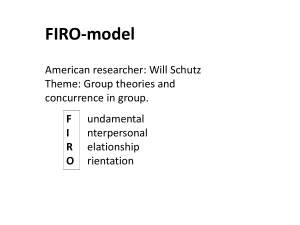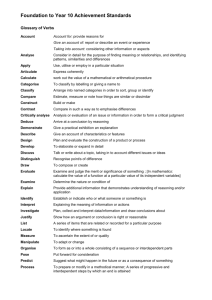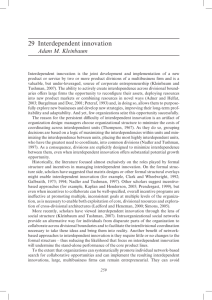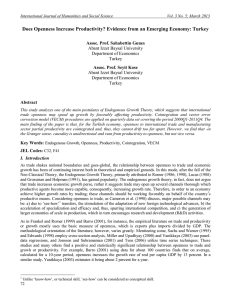Systems Theory - Westminster College
advertisement
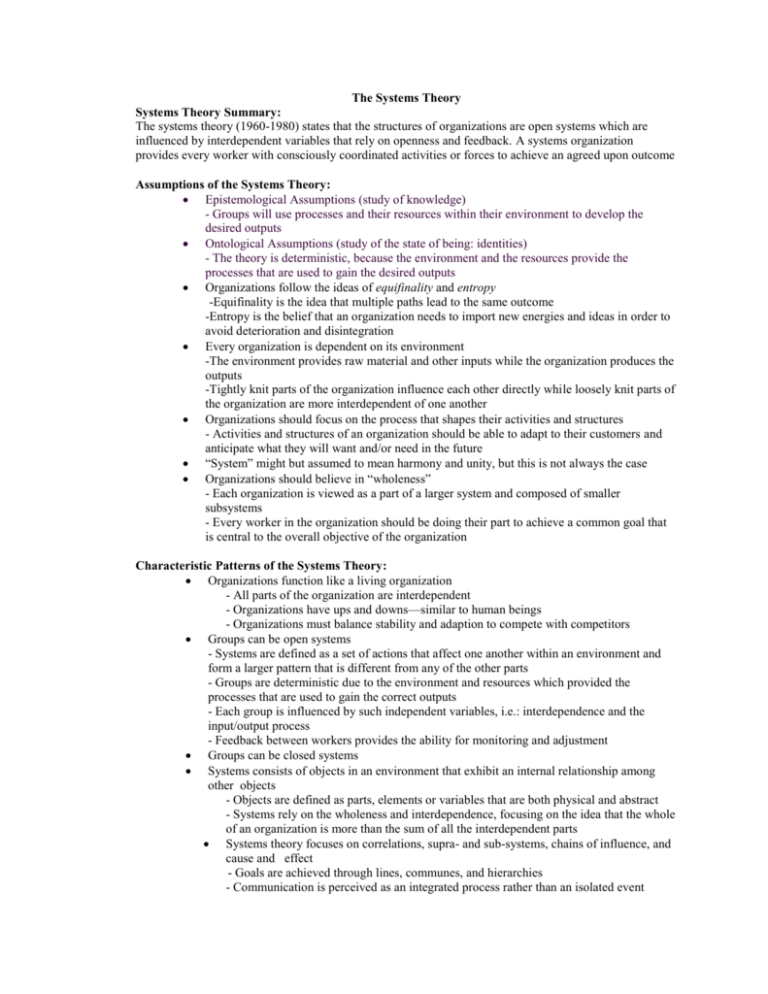
The Systems Theory Systems Theory Summary: The systems theory (1960-1980) states that the structures of organizations are open systems which are influenced by interdependent variables that rely on openness and feedback. A systems organization provides every worker with consciously coordinated activities or forces to achieve an agreed upon outcome Assumptions of the Systems Theory: Epistemological Assumptions (study of knowledge) - Groups will use processes and their resources within their environment to develop the desired outputs Ontological Assumptions (study of the state of being: identities) - The theory is deterministic, because the environment and the resources provide the processes that are used to gain the desired outputs Organizations follow the ideas of equifinality and entropy -Equifinality is the idea that multiple paths lead to the same outcome -Entropy is the belief that an organization needs to import new energies and ideas in order to avoid deterioration and disintegration Every organization is dependent on its environment -The environment provides raw material and other inputs while the organization produces the outputs -Tightly knit parts of the organization influence each other directly while loosely knit parts of the organization are more interdependent of one another Organizations should focus on the process that shapes their activities and structures - Activities and structures of an organization should be able to adapt to their customers and anticipate what they will want and/or need in the future “System” might but assumed to mean harmony and unity, but this is not always the case Organizations should believe in “wholeness” - Each organization is viewed as a part of a larger system and composed of smaller subsystems - Every worker in the organization should be doing their part to achieve a common goal that is central to the overall objective of the organization Characteristic Patterns of the Systems Theory: Organizations function like a living organization - All parts of the organization are interdependent - Organizations have ups and downs—similar to human beings - Organizations must balance stability and adaption to compete with competitors Groups can be open systems - Systems are defined as a set of actions that affect one another within an environment and form a larger pattern that is different from any of the other parts - Groups are deterministic due to the environment and resources which provided the processes that are used to gain the correct outputs - Each group is influenced by such independent variables, i.e.: interdependence and the input/output process - Feedback between workers provides the ability for monitoring and adjustment Groups can be closed systems Systems consists of objects in an environment that exhibit an internal relationship among other objects - Objects are defined as parts, elements or variables that are both physical and abstract - Systems rely on the wholeness and interdependence, focusing on the idea that the whole of an organization is more than the sum of all the interdependent parts Systems theory focuses on correlations, supra- and sub-systems, chains of influence, and cause and effect - Goals are achieved through lines, communes, and hierarchies - Communication is perceived as an integrated process rather than an isolated event - Each part of the organization affect and is affected by the other parts Systems Theorists and Practitioners: Ludwig von Bertalanffy: biologist/developer of systems theory Nikolas Luhmann; German sociologist and systems theorist Used by both Marx and Darwin in their development of theories Network Analysis in Open Systems Theory: Network Roles - Group or clique members: most important 1. Rely on interaction and interdependence 2. Made up of subgroups and cliques 3. Relies on coordination and relationships 4. Wholeness - Bridge: most important 1. Connects one variable to another (interaction) 2. Transfers feedback from environment and from within the system - Isolate: least important 1. No feedback/openness 2. No groups or interactions Dimensions of Analysis for Individuals - Connectedness and Accessibility: most important 1. Chains of influence supra and sub-systems 2. Based on feedback which relies on connectedness and accessibility 3. Each part affected by each other—outcome is a product of multiple actions - Centrality: least important 1. No real hierarchy in systems 2. All parts work together 3. The common goal is central, not an individual Dimensions of Analysis for Dyads - All elements important: strength, symmetry, directions, stability, multiplexity and openness. - Openness: most important 1. Everyone is connected to everyone and reflects ideas of each other 2. Rely on feedback from environment and between workers - Stability: most important 1. Environment needs stability and openness and can adjust based on feedback 2. Must balance stability and adaption to compete with competitors Dimensions of Analysis for Whole Networks - Clustering: most important 1. Subgroups and cliques make up system like a living organism 2. All parts are part of a larger system which is composed of smaller subsystems. - Most of communication: most important 1. Feedback - Size: least important 1. Not relevant to how a system works Cheney, George, Lars Thoger Christensen, Shiv Ganesh, and Theodore E. Zorn Jr. “Organizational Structure and Process.” Organizational Communication in an Age of Globalization. Long Grove: Waveland Press, Inc, 2004. Euske, Nancy A. and Karlene H. Roberts. “Evolving Perspectives in Organization Theory: Communication Implications.” Handbook of Organizational Communication: An Interdisciplinary Perspective. Ed. Frederic M. Jablin, Linda L. Putnam, Karlene H. Roberts, and Lyman W. Porter. Newbury Park: Sage Publications, 1987. 48-49 Infante, D.A., Rancer, A.S. & Womack, D.F. Building communication theory. Prospect Heights, Illinois: Waveland Press, 1997. Bertalanffy, von, L. General systems theory. New York: Braziller, 1968.




